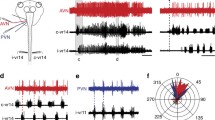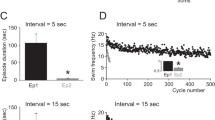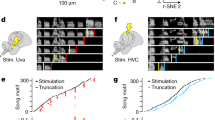Abstract
The hatchling Xenopus laevis tadpole was used to study the brain neurons controlling responsiveness. Tadpoles have reduced motor activity and responsiveness when they hang at rest, attached by cement gland mucus. Afferent input from cement gland mechanosensory neurons has both a phasic role in stopping swimming and a tonic role in reducing responsiveness while tadpoles hang attached. Both these roles depend on GABAA-mediated inhibition. We provide evidence supporting the hypothesis that long-term reduced responsiveness in attached tadpoles results from tonic activity in the reticulospinal GABAergic pathway mediating the stopping response. Two groups of putative stopping pathway interneurons were recorded in the caudal and rostral hindbrain of immobilised tadpoles. Both groups showed a sustained increase in activity during simulated attachment. This attached activity was irregular and unstructured. We consider whether low-level firing in cement gland afferents (at ~1 Hz) during simulated attachment is sufficient to explain the low-level firing (at ~0.5 Hz) in reticulospinal neurons. We then ask if a small population of these neurons (~20) could produce sufficient inhibition of spinal neurons to reduce the whole tadpole’s responsiveness. We conclude that for most of their 1st day of life GABAergic brainstem neurons could produce inhibition continuously while the tadpole is at rest.












Similar content being viewed by others
Abbreviations
- CV:
-
coefficient of variation
- EPSP:
-
excitatory postsynaptic potential
- IPSP:
-
inhibitory postsynaptic potential
- ISI:
-
interspike interval
References
Bässler U (1983) Neural basis of elementary behavior in stick insects. Studies of brain function, vol 10. Springer, Berlin Heidelberg New York
Boothby KM, Roberts A (1992a) The stopping response of Xenopus laevis embryos: behaviour, development and physiology. J Comp Physiol A 170:171–180
Boothby KM, Roberts A (1992b) The stopping response of Xenopus laevis embryos: pharmacology and intracellular physiology of rhythmic spinal neurons and hindbrain neurons. J Exp Biol 169:65–86
Edwards DH, Heitler WJ, Krasne FB (1999) Fifty years of a command neuron: the neurobiology of escape behavior in the crayfish. Trends Neurosci 22:153–161
Faisal AA, Matheson T (2001) Coordinated righting behaviour in locusts. J Exp Biol 204:637–648
Gargaglioni LH, Pereira AS. Hoffmann A (2001) Basal midbrain modulation of tonic immobility in the toad Bufo paracnemis. Physiol Behav 72:297–303
Gray J, Lissmann HW, Pumphrey RJ (1938) The mechanism of locomotion in the leech (Hirudo medicinalis Ray). J Exp Biol 15:408–430
Hayes BP, Roberts A (1983) The anatomy of two functional types of mechanoreceptive ‘free’ nerve-ending in the head skin of Xenopus embryos. Proc R Soc London Ser B 218:61–76
Krämer K, Markl H (1978) Flight-inhibition on ground contact in the American cockroach, Periplaneta americana. I. Contact receptors and a model for their central connections. J Insect Physiol 24:577–586
Krasne FB, Wine JJ (1975) Extrinsic modulation of crayfish escape behaviour. J Exp Biol 63:433–450
Lambert TD, Howard J, Plant A, Soffe S, Roberts A (2004) Mechanisms and significance of reduced activity and responsiveness in resting frog tadpoles. J Exp Biol (in press)
Li W-C, Soffe SR, Roberts A (2002) The spinal inhibitory neurons that modulate cutaneous sensory pathways during locomotion in a simple vertebrate. J Neurosci 22:10924–10934
Li W-C, Perrins R, Walford A, Roberts A (2003) The neuronal targets for GABAergic reticulospinal inhibition that stops swimming in hatchling frog tadpoles. J Comp Physiol A 189:29–37
Monassi CR, Hoffmann A, Menescal D (1997) Involvement of the cholinergic system and periaqueductal gray matter in the modulation of tonic immobility in the guinea pig. Physiol Behav 62:53–59
Nieuwkoop PD, Faber J (1956) Normal tables of Xenopus laevis (Daudin). North Holland Publishing, Amsterdam
Nishino H, Sakai M (1996) Behaviorally significant immobile state of so called thanatosis in the cricket Gryllus bimaculatus DeGeer. Its characterization, sensory mechanism and function. J Comp Physiol A 179:613–624
Perkel DH, Gerstein GL, GP Moore (1967) Neuronal spike trains and stochastic point processes. I. The single spike train. Biophys J 7:391–418
Perrins R, Walford A, Roberts A (2002) Sensory activation and role of inhibitory reticulospinal neurons that stop swimming in hatchling frog tadpoles. J Neurosci 22:4229–4240
Pringle JWS (1974) Locomotion: flight. In: Rockstein M (ed) The physiology of the Insecta, vol III. Academic Press, London, pp 433–476
Reith CA, Sillar KT (1997) Pre- and postsynaptic modulation of spinal GABAergic neurotransmission by the neurosteroid, 5β-pregnan-3α-ol-20-one. Brain Res 770:202–212
Roberts A (1980) The function and role of two types of mechanoreceptive ‘free’ nerve endings in the head skin of amphibian embryos. J Comp Physiol A 135:341–348
Roberts A, Blight AR (1975) Anatomy, physiology and behavioural role of sensory nerve endings in the cement gland of embryonic Xenopus. Proc R Soc London Ser B 192:111–127
Roberts A, Dale N, Ottersen OP, Storm-Mathisen J (1987) The early development of neurons with GABA immunoreactivity in the CNS of Xenopus laevis embryos. J Comp Neurol 261:435–449
Roberts A, Hill NA, Hicks R (2000) Simple mechanisms organise orientation of escape swimming in embryos and hatchling tadpoles of Xenopus laevis. J Exp Biol 203:1869–1885
Vu ET, Krasne FB (1993a) Crayfish tonic inhibition: prolonged modulation of behavioral excitability by classical GABAergic inhibition. J Neurosci 13:4394–4402
Vu ET, Krasne FB (1993b) The mechanism of tonic inhibition of crayfish escape behavior: distal inhibition and its functional significance. J Neurosci. 1993: 4379–4393
Acknowledgements
We should like to thank Derek Dunn, Julie Hansen and Linda Teagle for technical assistance and Keith Sillar for comments on the manuscript. We are also very grateful to the University of Bristol for providing a postgraduate scholarship to T.D.L. The experiments reported in this paper comply with the Principles of animal care, publication No. 8623, revised 1985 of the National Institutes of Health and with the regulations of the Home Office in the United Kingdom.
Author information
Authors and Affiliations
Corresponding author
Rights and permissions
About this article
Cite this article
Lambert, T.D., Li, WC., Soffe, S.R. et al. Brainstem control of activity and responsiveness in resting frog tadpoles: tonic inhibition. J Comp Physiol A 190, 331–342 (2004). https://doi.org/10.1007/s00359-004-0505-8
Received:
Revised:
Accepted:
Published:
Issue Date:
DOI: https://doi.org/10.1007/s00359-004-0505-8




